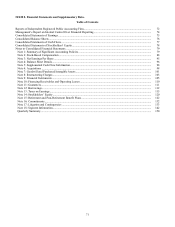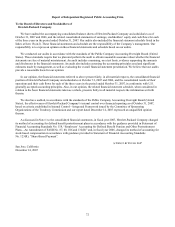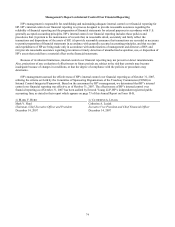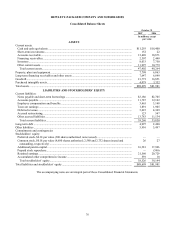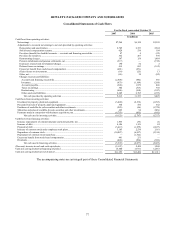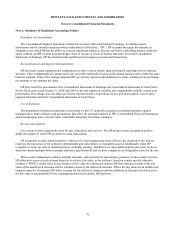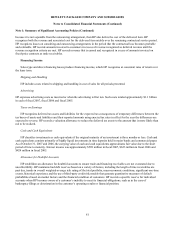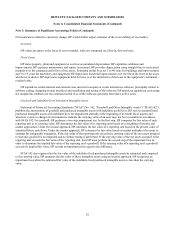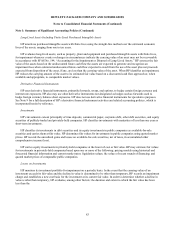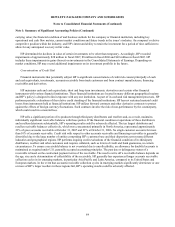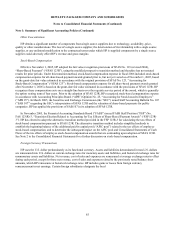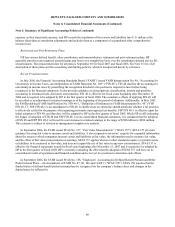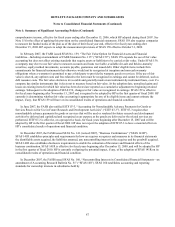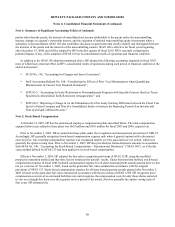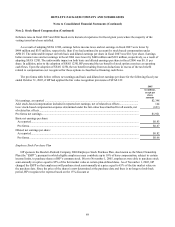HP 2007 Annual Report Download - page 95
Download and view the complete annual report
Please find page 95 of the 2007 HP annual report below. You can navigate through the pages in the report by either clicking on the pages listed below, or by using the keyword search tool below to find specific information within the annual report.HEWLETT-PACKARD COMPANY AND SUBSIDIARIES
Notes to Consolidated Financial Statements (Continued)
Note 1: Summary of Significant Accounting Policies (Continued)
because it is not separable from the outsourcing arrangement, then HP also defers the cost of the delivered item. HP
recognizes both the revenue and associated cost for the delivered item ratably over the remaining contractual service period.
HP recognizes losses on consulting and outsourcing arrangements in the period that the contractual loss becomes probable
and estimable. HP records amounts invoiced to customers in excess of revenue recognized as deferred revenue until the
revenue recognition criteria are met. HP records revenue that is earned and recognized in excess of amounts invoiced on
fixed-price contracts as trade receivables.
Financing Income
Sales-type and direct-financing leases produce financing income, which HP recognizes at consistent rates of return over
the lease term.
Shipping and Handling
HP includes costs related to shipping and handling in cost of sales for all periods presented.
Advertising
HP expenses advertising costs as incurred or when the advertising is first run. Such costs totaled approximately $1.1 billion
in each of fiscal 2007, fiscal 2006 and fiscal 2005.
Taxes on Earnings
HP recognizes deferred tax assets and liabilities for the expected tax consequences of temporary differences between the
tax bases of assets and liabilities and their reported amounts using enacted tax rates in effect for the year the differences are
expected to reverse. HP records a valuation allowance to reduce the deferred tax assets to the amount that is more likely than
not to be realized.
Cash and Cash Equivalents
HP classifies investments as cash equivalents if the original maturity of an investment is three months or less. Cash and
cash equivalents consists primarily of highly liquid investments in time deposits held in major banks and commercial paper.
As of October 31, 2007 and 2006, the carrying value of cash and cash equivalents approximates fair value due to the short
period of time to maturity. Interest income was approximately $598 million in fiscal 2007, $623 million in fiscal 2006 and
$424 million in fiscal 2005.
Allowance for Doubtful Accounts
HP establishes an allowance for doubtful accounts to ensure trade and financing receivables are not overstated due to
uncollectibility. HP maintains bad debt reserves based on a variety of factors, including the length of time receivables are
past due, trends in overall weighted-average risk rating of the total portfolio, macroeconomic conditions, significant one-time
events, historical experience and the use of third-party credit risk models that generate quantitative measures of default
probabilities based on market factors and the financial condition of customers. HP records a specific reserve for individual
accounts when HP becomes aware of a customer’ s inability to meet its financial obligations, such as in the case of
bankruptcy filings or deterioration in the customer’ s operating results or financial position.
81


